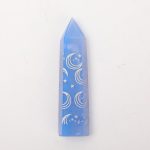The captivating shades of blue found in the mineral kingdom offer a captivating glimpse into the wonders of nature’s artistry. From the vibrant azure of lapis lazuli to the deep indigo of azurite, these mineral treasures possess not only aesthetic charm but also a rich history and valuable properties that have made them prized by civilizations throughout time.

The Science of Blue Rock Minerals
The vibrant hues of blue rock minerals stem from the unique ways in which light interacts with their crystal structures. When light strikes a mineral, some wavelengths are absorbed while others are reflected. The wavelengths that are reflected determine the color we perceive.
In blue rock minerals, copper is often the culprit behind their distinctive coloration. When copper ions are present within the crystal structure, they create absorption bands in the red and yellow parts of the spectrum, resulting in the reflection of blue light. The exact shade of blue depends on the concentration and arrangement of copper ions within the mineral.
Types of Blue Rock Minerals
The world of blue rock minerals encompasses a diverse spectrum of species, each with its own unique characteristics and applications. Here are some of the most notable examples:
Lapis Lazuli
- Color: Vibrant azure blue
- Mohs Hardness: 5-6
- Composition: Silicate mineral containing lazurite, calcite, and pyrite
- Applications: Jewelry, ornaments, paint pigments, cosmetic products
Azurite
- Color: Deep indigo blue
- Mohs Hardness: 3.5-4
- Composition: Copper carbonate mineral
- Applications: Jewelry, decorative objects, paint pigments
Turquoise
- Color: Sky blue to greenish blue
- Mohs Hardness: 5-6
- Composition: Hydrated copper aluminum phosphate
- Applications: Jewelry, ornaments, healing stones
Blue Sodalite
- Color: Deep blue with white or gray inclusions
- Mohs Hardness: 5.5-6
- Composition: Sodium aluminum silicate
- Applications: Jewelry, decorative objects, healing stones
Blue Kyanite
- Color: Steel blue to sapphire blue
- Mohs Hardness: 4.5-5
- Composition: Aluminum silicate
- Applications: Jewelry, industrial abrasives, high-temperature insulation
Properties and Benefits of Blue Rock Minerals
Beyond their captivating aesthetics, blue rock minerals also boast a range of valuable properties and potential health benefits.
Spiritual and Healing Properties
In many cultures, blue rock minerals are associated with tranquility, wisdom, and spiritual enlightenment. They are believed to promote clarity of mind, reduce stress, and enhance communication abilities. Some practitioners of alternative medicine use blue gemstones in crystal healing to balance the energy centers of the body.
Antioxidant and Anti-Inflammatory Properties
Research suggests that some blue rock minerals, such as sodalite and turquoise, may possess antioxidant and anti-inflammatory properties. These properties could potentially protect the body against damage caused by free radicals and inflammation.
Use in Jewelry and Decorative Arts
The beauty and durability of blue rock minerals make them highly sought-after materials for jewelry and decorative arts. Lapis lazuli and turquoise have been used for centuries to create stunning necklaces, earrings, and other adornments. Blue sodalite and kyanite are popular choices for inlay work and sculptures.
Blue Rock Minerals in Emerging Applications
The unique properties of blue rock minerals are inspiring researchers and entrepreneurs to explore novel applications in a variety of fields.
Thermal Insulation: Blue kyanite possesses exceptional thermal insulation properties, making it a promising material for high-temperature applications, such as aerospace and industrial furnaces.
Water Purification: Some blue rock minerals, such as sodalite and azurite, have been shown to have water purification capabilities. They could potentially be used in water filtration systems to remove impurities and improve water quality.
Technologically Advanced Materials: Researchers are exploring the use of blue rock minerals in the development of technologically advanced materials, such as energy-efficient batteries and nanocomposites.
Table 1: Blue Rock Minerals and Their Compositions
| Mineral Name | Chemical Composition |
|---|---|
| Lapis Lazuli | Silicate mineral containing lazurite, calcite, and pyrite |
| Azurite | Copper carbonate mineral |
| Turquoise | Hydrated copper aluminum phosphate |
| Blue Sodalite | Sodium aluminum silicate |
| Blue Kyanite | Aluminum silicate |
Table 2: Mohs Hardness of Blue Rock Minerals
| Mineral Name | Mohs Hardness |
|---|---|
| Lapis Lazuli | 5-6 |
| Azurite | 3.5-4 |
| Turquoise | 5-6 |
| Blue Sodalite | 5.5-6 |
| Blue Kyanite | 4.5-5 |
Table 3: Applications of Blue Rock Minerals
| Mineral Name | Applications |
|---|---|
| Lapis Lazuli | Jewelry, ornaments, paint pigments, cosmetic products |
| Azurite | Jewelry, decorative objects, paint pigments |
| Turquoise | Jewelry, ornaments, healing stones |
| Blue Sodalite | Jewelry, decorative objects, healing stones |
| Blue Kyanite | Jewelry, industrial abrasives, high-temperature insulation |
Table 4: Potential Health Benefits of Blue Rock Minerals
| Mineral Name | Potential Health Benefits |
|---|---|
| Lapis Lazuli | Tranquility, wisdom, spiritual enlightenment |
| Azurite | Clarity of mind, stress reduction |
| Turquoise | Antioxidant, anti-inflammatory |
| Blue Sodalite | Antioxidant, anti-inflammatory |
| Blue Kyanite | Not known |
FAQs
1. Are blue rock minerals rare?
Some blue rock minerals, such as lapis lazuli and turquoise, are relatively rare, while others, such as blue sodalite and kyanite, are more common.
2. Can blue rock minerals be used in jewelry?
Yes, many blue rock minerals, such as lapis lazuli, turquoise, and sodalite, are used extensively in jewelry making.
3. What is the spiritual significance of blue rock minerals?
In many cultures, blue rock minerals are associated with tranquility, wisdom, and spiritual enlightenment.
4. Do blue rock minerals have any medicinal properties?
Some blue rock minerals, such as turquoise and sodalite, have been used in traditional medicine to promote healing and well-being.
5. Are blue rock minerals suitable for all skin tones?
The deep, vibrant shades of blue rock minerals can complement a wide range of skin tones.
6. How can I care for blue rock minerals?
To preserve the beauty and longevity of blue rock minerals, avoid exposing them to harsh chemicals, heat, or sunlight. Clean them gently with a soft cloth or brush.
7. Where can I find blue rock minerals?
Blue rock minerals can be found in various locations around the world, including Afghanistan, Chile, China, Egypt, Iran, Mexico, and the United States.
8. What are blue rock minerals used for?
Blue rock minerals are used in a variety of applications, including jewelry, decorative arts, industrial abrasives, high-temperature insulation, water purification, and potential technological advancements.




























